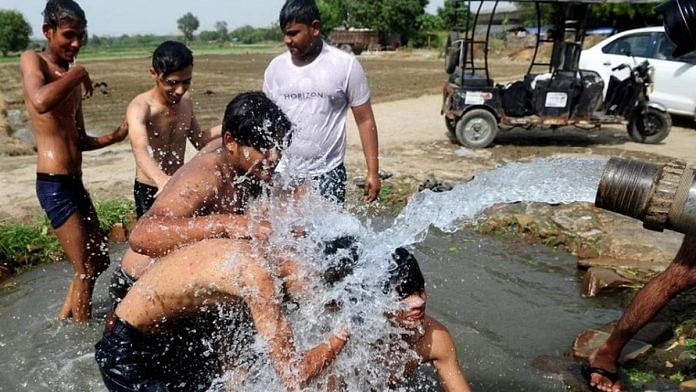New Delhi: The heatwaves over India and Bangladesh last month were 2 degrees Celsius hotter than they would otherwise be due to human-induced climate change, with high humidity in such early heatwaves playing a devastating role, according to a new research from the World Weather Attribution (WWA).
WWA is an initiative by climate scientists to provide robust assessments on the role of climate change in the aftermath of an extreme weather event.
Last year, India experienced an early and unusually long heatwave spell that was made 30 times more likely on account of climate change, a similar study by WWA had said. However, what makes the latest WWA findings stand out is the role of humidity in such heatwaves, which have different impacts (on agriculture and health).
“Although the event happened earlier in March and April last year, it was a dry event where the prolonged effects were more on the crops, and the health impacts were less,” said Mariam Zachariah, lead author of the study released Wednesday.
Last year, the heatwave curtailed India’s wheat production to 100 million tonnes, against local consumption of 103 million tonnes, according to media reports.
“This time we see that the health impacts were more, especially in the coastal regions and in the coastal cities, and this was associated with humid conditions. Looking at the trends in temperatures from last year, and looking at the trends in heat index this year, we can expect humid heat waves as well as prolonged heat, dry heat conditions to increase in the next few years,” Zachariah added.
A heat index is “reflective of the human body’s comfort” to the combined effects of temperature and humidity.
Temperatures crossed 40 degrees Celsius in India between 16 and 20 April this year.
Though hot and humid heatwaves are not unusual for the India-Bangladesh region, their intensity and frequency will increase by a factor of 3 if mean global surface temperatures cross 2 degrees, the WWA said in its latest study.
Mean surface temperatures are already 1.2 degrees higher than pre-industrial levels, which have caused heatwaves over India and Bangladesh to become 2 degrees hotter and, this year, 26 times more likely to occur, according to the study.
The dynamics of the impact of heatwaves and their nature as a hazard are still being studied.
A recent report by the Centre for Policy Research found that most heat action plans aimed at mitigating impacts had an “oversimplified understanding” of heatwaves and how to address them.
“We see again and again that climate change dramatically increases the frequency and intensity of heatwaves, one of the deadliest weather events there are. Still, heat action plans are only being introduced very slowly across the globe. They need to be an absolute priority adaptation action everywhere, but in particular in places where high humidity enhances the impacts of heatwaves,” said Friederike Otto, senior lecturer in Climate Science at the UK-based Grantham Institute for Climate Change and the Environment in a statement. She also leads the WWA initiative.
The WWA study was done in collaboration with 22 researchers from universities and institutes across the world, including India, Thailand, Australia, Denmark, France, Germany, Kenya, the Netherlands, the UK, and the US.
Apart from India and Bangladesh, the study also evaluated the impact of extreme humid heat in Thailand and Lao People’s Democratic Republic (Lao PDR).
Also Read: India’s early heatwave sign of climate change, could be more dangerous to health, say experts
‘Dangerous’ level of heat
The WWA’s analysis combines temperature data with relative humidity to create a heat index.
A heat index temperature below 27 degrees is considered “low risk” while a temperature in the range of 41 to 54 degrees is considered a “danger”, and above 54 degrees “extreme danger”.
Several parts of the regions assessed in the report crossed 40 degrees on the Heat Index, making the heat “dangerous”.
High levels of heat also have compounding negative effects, like increasing forest fires and air pollution, and exacerbating urban island heat effects.
In Thailand and Lao PDR, humid heatwaves such as the one that passed this April are rare, and would “have been virtually impossible to have occurred without climate change”. The heat wave was 2.3 degrees hotter on account of climate change, according to the study.
The population most vulnerable to heat-related illnesses and mortality varied from region to region. However, the elderly, women, outdoor workers, and those living in informal settlements tend to be most affected.
In April, at least 13 people died due to heat exposure in Maharashtra during a poorly planned outdoor event.
“While early warnings were sent out on the heatwave (especially in India), it is not clear whether they arrived early enough to allow people adequate time to prepare in advance, as the majority of the action was taken once the heat and humidity had already arrived,” says the study.
“With heatwaves like this one becoming more frequent and intense, it will be important to better comprehend systematic inequalities and multidimensional vulnerabilities and how they interact with heat exposure, and avoid reinforcing existing patterns of exclusion,” it added.
(Edited by Anumeha Saxena)
Also Read: IMD forecasts ‘slight but not significant delay’ in arrival of Southwest Monsoon this year



